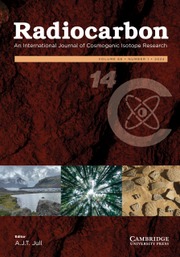Introduction
Human history contains events of great interest to researchers as well as to the general public. Such events are usually associated with significant socio-economic changes and high mortality rates. Plague epidemics and famines are undoubtedly among the most important events studied by a wide range of scientific disciplines. Historically, there are three main known plague pandemics. The first was the Justinian Plague, which began in 541–544 AD and lasted until ∼750 AD. The second is most commonly referred to as the Black Death (1347–1351 AD), which had been recurring until the 18th century. The third emerged in China in the 1850s and lasted until the mid-20th century (Benedictow Reference Benedictow2021; Harbeck et al. Reference Harbeck, Seifert, Hänsch, Wagner, Birdsell, Parise, Wiechmann, Grupe, Thomas and Keim2013; Little et al., Reference Little, Hays, Morony, Kennedy, Stathakopoulos, Sarris, Stoclet, Kulikowski, Maddicott and Dooley2007). In historical sources, it is possible to trace two other earlier events referred to as plagues, the Plague of Athens (430–427 BC) and the Antonine Plague (165–180 AD), but there is a lack of evidence that these were actually plagues in the modern sense of the word, i.e., caused by the bacterium Yersinia pestis (Dancourt and Raoult Reference Drancourt and Raoult2002; McNeill Reference McNeill1976; Rasmussen et al. Reference Rasmussen, Allentoft, Nielsen, Orlando, Sikora, Sjögren, Pedersen, Schubert, Van Dam and Kapel2015). Similarly, famines have occurred several times in our history (Ljungqvist et al. Reference Ljungqvist, Seim and Collet2023), always due to the coincidence of some specific features; for example complicated socio-political situation, accumulating of adverse weather patterns, failures of key agricultural crops and several other features (Brázdil et al. Reference Brázdil, Kotyza, Bauch, Collet and Schuh2018).
Despite the usually good historical record of these events, it can be very difficult to link an archaeological finding to a specific catastrophic event. One such archaeological site is the cemetery surrounding the Chapel of All Saints in Kutná Hora–Sedlec, Czech Republic. This site probably contains, in addition to the burials of people who died of natural causes, victims of the famine of 1318 and the Black Death of 1348, buried in 32 mass graves (Brzobohatá et al. Reference Brzobohatá, Frolík and Velemínský2023a; Frolík Reference Frolík2017). In this paper, we employ a methodology that combines the number of individuals and the decubitus form to define a mass grave. A mass grave was defined as any grave that contained three or more individuals buried in multiple vertical layers where individuals must be in physical contact. Additionally, the mass grave could be described as a single stratigraphic unit, indicating that the burial of the individuals occurred as a discrete event. In some cases, however, only one or two individuals could be used for radiocarbon dating due to taphonomy, diagenetic, or contextual factors (for comparison: Hanglund Reference Haglund, Haglund and Sorg2002; Skinner Reference Skinner1987; Skinner et al. Reference Skinner, York, Connor, Haglund and Sorg2002).
Based on the combination of archaeological stratigraphic data, historical sources and found artifacts, it was possible to interpret a few of the graves and assign them to a specific event. In addition, two separate studies (anthropological and cementochronological) were conducted to identify additional mass graves with varying degrees of success (Lépinau et al. Reference Lépinau, Castex, Brzobohatá, Frolík, Velímský, Brůžek, Velemínský and Kacki2021; Zazvonilová et al. Reference Zazvonilová, Brzobohatá, Frolík, Velemínský and Brůžek2023). In this study, we solely focus on another used method, radiocarbon dating of individuals from the mass graves in an attempt to complement previous results and interpret the remaining mass graves.
Historical and archaeological background
The Chapel of All Saints with an ossuary in Kutná Hora–Sedlec represents a unique monument even on a global scale (Figure 1). The chapel is located in a former lay cemetery as part of the now extinct Cisterian monastery. The chapel was built after 1380 CE, repaired in the late 15th century after damage during the Hussite Wars, and fundamentally rebuilt by the architect J. Santini Aichl in the early 18th century. The interior furnishings consist of isolated human bones since the 16th century, last modified in the 19th century. The bones that decorate the interior of the ossuary come from several tens of thousands of individuals (for the phenomenon of the ossuary and its transformations, see Horák et al. Reference Horák, Weiss-Krejci, Frolík, Velímský, Šmejda, Weiss Krejci, Becker and Schwyzer2022).
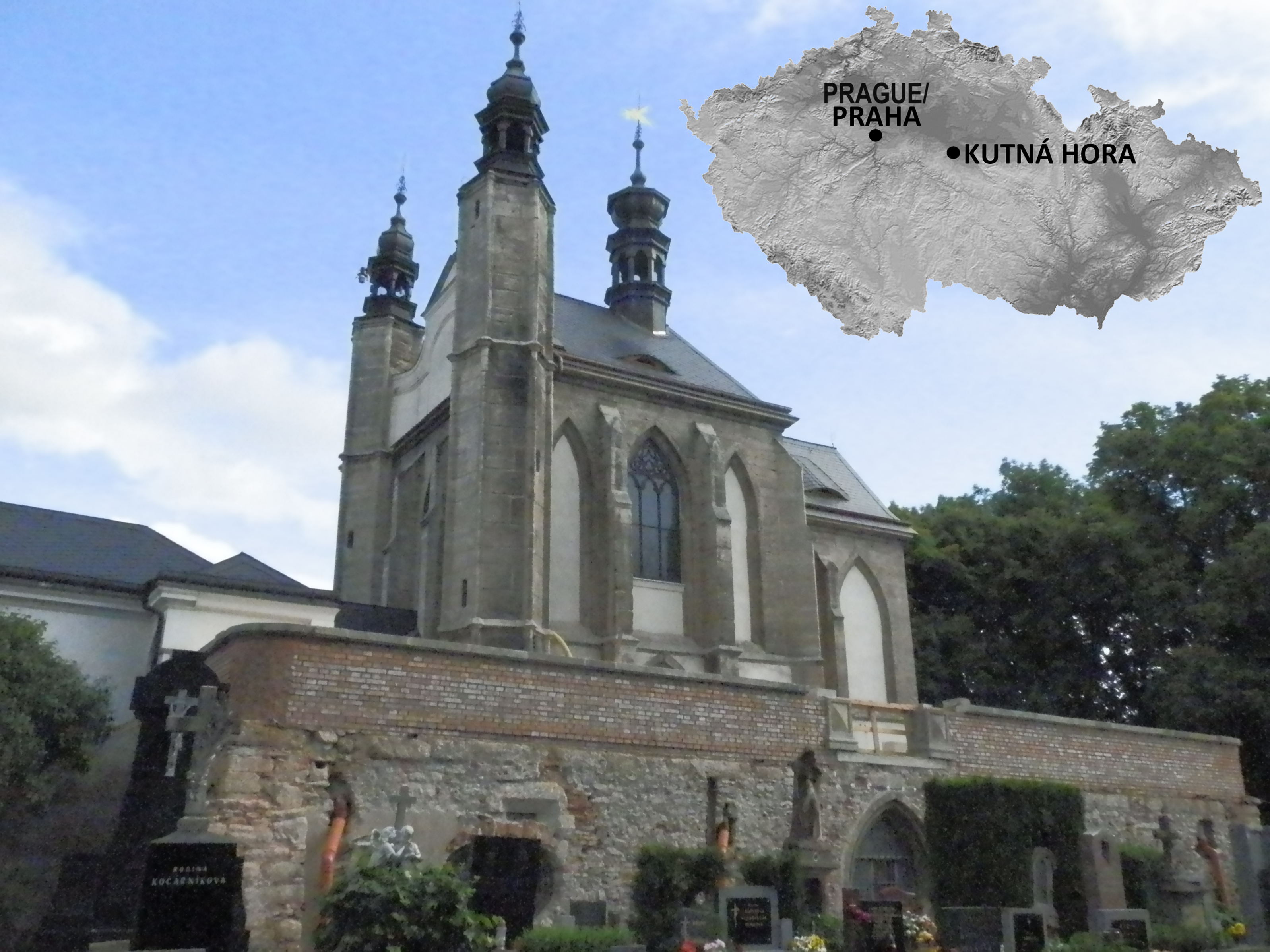
Figure 1. Kutná Hora–Sedlec, Chapel of All Saints with ossuary and its location within the Czech Republic. View from the southwest (figure borrowed with permission of the journal editors from Brzobohatá et al. Reference Brzobohatá, Frolík and Velímský2023b).
The problems with statics of the building caused the need to first carry out rescue archaeological research around the ossuary from 2016 to 2018 and in 2019 and 2020 partly in the interior of the building. An important part of the found collection was 32 mass graves outside the ossuary (Figure 2). They were investigated to varying degrees, given the fact that archaeological research was limited to a two-meter-wide strip around the perimeter of the ossuary. A total of 1817 burials (skeletons) were examined, more than half of which were placed in mass graves. 907 individuals were anthropologically evaluated, of which 322 were juveniles (Brzobohatá et al. Reference Brzobohatá, Frolík and Velemínský2023a; Frolík Reference Frolík2017). The total number of mass graves remains unknown as does the extent of the cemetery, but the overall situation suggests that the mass graves were dug on the northern edge of the cemetery (Brzobohatá et al. Reference Brzobohatá, Frolík and Velemínský2023a). Based on the uniquely preserved stratigraphic situation, it is possible to connect some mass graves with specific catastrophic events. However, mass graves belong to two stratigraphic phases. The third one is foundation wall of the chapel/ossuary built in 1380s. The mass graves are older.

Figure 2. Kutná Hora–Sedlec, ossuary. The graves filled with blue are those interpreted as plague graves according to stratigraphy and numismatics, in yellow are those interpreted as famine graves according to stratigraphy. In gray and italics are the numbers of mass graves, in black the numbers of analyzed individuals. The blue and red lines indicate the extent of the surveyed area (figure borrowed and modified with permission of the journal editors from Brzobohata et al. Reference Brzobohatá, Frolík and Velímský2023b).
Two past disasters are documented in written sources. First, the famine of 1318, is documented in written sources directly for Kutná Hora, including information about the burials “in front of the Sedlec Gate” (Zbraslav Chronicle II/3; FRB IV 1884, 248). Stratigraphically older mass graves are attributed to this event. For the stratigraphically younger graves, a plague epidemic in the years 1348–1350 CE is suggested, for which there are only sparse reports from Bohemia and for Kutná Hora none. It was generally believed that the plague epidemic did not reach Bohemia at that time (Mengel Reference Mengel2011). However, from the point of view of the stratigraphy of the cemetery in Sedlec, the younger deadly catastrophe most likely had occurred after 1318 CE and before 1380 CE. On this basis, we can connect five mass graves (Graves 2, 10, 13, 24, 30) with the famine of 1318 CE, and five other graves (No. 1, 11, 12, 23, 29) to the plague epidemic between 1348 CE and 1350 CE. The remaining 22 mass graves do not have this possibility.
Attention was therefore focused on the evidence of the treatment of the dead in an attempt to find out the differences that would allow us to distinguish the two disasters. No differences were found in the burial of the deceased and their grave goods, and they did not differ from the deceased buried in individual graves. Differences were not found even when analyzing the physical characteristics of the buried (Lépineau et al. Reference Lépinau, Castex, Brzobohatá, Frolík, Velímský, Brůžek, Velemínský and Kacki2021; Brzobohatá et al. Reference Brzobohatá, Frolík and Velemínský2023a). Burials are mostly very poor in grave goods. The exception is iron or bronze buckles in the number of one to three, some even with small torsos of a leather belt. These graves clearly belong to men and no similar guidelines were found for female burials. Individuals carrying cash were examined in three graves. Nine coins of the king John of Luxembourg from period 1340–1346 CE and one from the period 1318–1327 CE were identified in grave H184 (mass grave 21). The composition of the group of Prague groschen from grave H232 (mass grave 18) is similar. One was minted in the period 1311–1318 CE, the others in 1318–1346 CE (Castelin Reference Castelin1960; Hána Reference Hána2008). In grave H1803 (mass grave 26), the deceased originally had a knife, a whistle, and small coins—parves of Jan of Luxembourg in a pouch near his waist. These individuals were apparently buried in their clothing and were not searched beforehand. A fear of contagion is offered as an explanation, which would suggest an interpretation of the mass grave as a plague, although death from a contagious disease due to weakening by starvation cannot be ruled out. If considering these findings, the number of plague graves would rise to eight (1, 11, 12, 18, 21, 23, 26, 29).
The set of skeletal remains from mass grave is the largest researched set of this kind in Europe to date, and it can be used to obtain unique data on the population of a rapidly developing city related to clearly defined periods of time (Brzobohatá et al. Reference Brzobohatá, Frolík and Zazvonilová2019; Castex Reference Castex, Raoult and Drancourt2008). Further efforts were therefore focused on radiocarbon dating that would allow attributing the remaining mass graves to the mentioned disasters, possibly to confirm the previous conclusions (Zazvonilová et al. Reference Zazvonilová, Brzobohatá, Frolík, Velemínský and Brůžek2023).
Material and methods
Sampling
In the present study, 95 bones and 85 teeth were used for the purpose of radiocarbon dating. These samples were yielded from 95 individuals buried in the cemetery adjacent to the Chapel of All Saints in Kutná Hora–Sedlec. The individuals came mostly from mass graves, but several individuals engaged in this assessment preceded the events connected with mass graves.
During the archaeological excavation, 32 mass graves were at least partially uncovered. For the purpose of this study, individuals from 17 of these graves were involved. Of these, three (2, 10 and 13) were archaeologically and historically connected with famine (1318 CE). The six graves (1, 11, 12, 18, 21 and 29) were archaeologically and historically connected with the plague (1348–1350 CE). The remaining eight mass graves involved in the study could not be contextually linked to either of these two events. The remaining individuals (11) were assessed as being older than the mass graves and were buried separately within the etage cemetery. The individuals from the remaining mass graves were not included in the study because they did not meet the age criteria or did not have preserved both bone and tooth for Bayesian modeling.
All individuals included in the study provided bone and tooth samples for radiocarbon dating, except for ten individuals whose state of preservation did not allow for the involvement of teeth. These individuals were not involved in the Bayesian modeling process. Their role was to verify the stratigraphy and chronological classification of the mass graves. Further details about all samples included in the study can be found in Supplementary Table 1. The table contains the number of mass graves and the number of individuals from which the samples originate, the type of sample, and the laboratory number of each sample.
In our study, we assumed that the dated episode in tooth roots is approximately the time of tooth eruption. For bone sampling, preference was given to clavicles and ribs, where we assumed that their age is closest to the time of death even in old individuals (Handlos et al. Reference Handlos, Svetlik, Horáčková, Fejgl, Kotik, Brychova, Megisova and Marecova2018).
The aim of tooth-bone pair sampling was to suppress dating ambiguities in the groups of individuals studied, resulting from the non-monotonic course of the radiocarbon calibration curve during the period under investigation.
Anthropology
All sampled individuals were subject to an anthropological assessment, with particular consideration given to basic demographic parameters such as age at death, sex, and physical characteristics of the deceased. Additionally, a basic paleopathological assessment was conducted. However, for the purposes of this study, only the age at death results were deemed relevant, and thus the remaining demographic assessments were not incorporated into further analyses. Further information regarding the anthropological evaluation of the total assemblage from the archaeological site Chapel of All Saints with an ossuary in Kutná Hora–Sedlec can be found in Brzobohatá et al. (Reference Brzobohatá, Frolík and Velímský2023b).
Supplementary Table 1 also contains the results of the anthropological assessment of age at death and the interpretation of mass graves based on stratigraphy and archaeological findings. The age at death results is presented in the form of age categories (Table 1).
Table 1. Age categories of anthropological analysis and defined abbreviations.

Radiocarbon dating and stable isotope analysis
All samples were processed in the laboratory CRL of the Nuclear Physics Institute (NPI) of the Czech Academy of Science. The procedure consisted of mechanical cleaning, pre-treatment, and collagen extraction (Brock et al. Reference Brock, Higham, Ditchfield and Ramsey2010; Frolik et al. Reference Frolík, Sneberger, Svetlik, Drtikolová Kaupová, Pachnerová Brabcová and Ovsonkova2020; Gupta and Polach Reference Gupta and Polach1985; Jull et al. Reference Jull, Burr, Beck, Hodgins, Biddulph, Gann, Hatheway, Lange and Lifton2006; Law and Hedges Reference Law and Hedges1989; Longin Reference Longin1971), filtration with glass fiber filter or ultrafiltration to remove fraction below 30 kDa.
For the radiocarbon measurement, the samples underwent graphitization (Orsovszki and Rinyu Reference Orsovszki and Rinyu2015; Rinyu et al. Reference Rinyu, Orsovszki, Futó, Veres and Molnár2015). Graphitized samples were measured on AMS systems MILEA at NPI (Kučera et al. Reference Kučera, Maxeiner, Müller, Němec, John, Světlík, Kameník, Dreslerová, Pachnerová Brabcová, Tecl, Bourquin, Herrmann and Fahrni2022, Reference Kučera, Pachnerová Brabcová, Němec, Kameník, Trubač, Brychová, Světlík, John, Garba and Daňo2023) or MICADAS (DeA laboratory, Hungary). AMS data were processed using BATS freeware (Wacker et al. Reference Wacker, Christl and Synal2010) and calibrated with OxCal 4.4. software and IntCal20 calibration curve (Bronk Ramsey Reference Bronk Ramsey2009; Reimer et al. Reference Reimer, Austin, Bard, Bayliss, Blackwell, Bronk Ramsey, Butzin, Cheng, Edwards and Friedrich2020).
For coupled N and C isotope analysis, collagen triplicates of 650–750 µg were weighed into tin capsules. The isotope ratios were determined using elemental analyser Flash IRMS with TCD detector coupled to Continuous flow IV and Delta V Advantage mass spectrometer. The isotope ratios were expressed as δ values (Werner and Brand Reference Werner and Brand2001). The ratios were normalised using four international standards (IAEA-N1, IAEA-N2, IAEA-CH3, IAEA-600) and four reference collagens (Stabilisotopenanalytik 2018). The C isotope ratios were reported against the Vienna Pee Dee Belemnite (VPDB) scale and the N isotope ratios were reported against the atmospheric N2.
Bayesian modeling
Only the results of radiocarbon dating of tooth-bone pairs were used for modeling. For each skeleton, we calculated posterior probabilities of two hypotheses
conditioned on the CRA (conventional radiocarbon activity) of bone (CRA b ) and tooth (CRA t ). The hypothesis concerns the year of death and has following alternatives: H f that the individual died of famine and alternative H p that they died of plague according to Bayes´ formula:
All information about CRA for the given hypothesis is contained in bone age and tooth age (t b and t t ). Their probabilities depend, in addition to hypothesis H, on biological age a as
For given t b and t t , CRA b and CRA t are independent:
and the age of the bone and tooth are independent for given hypothesis and biological age a:
By substituting, we obtain the posterior probability of the hypothesis as the integral of the product of the known probability densities. It includes calibration:
the bone and tooth age model at the time of the death:
The bone lag time, representing the delay between the actual year of death and bone formation, was estimated based on data from Ubelaker et al. (Reference Ubelaker, Thomas and Olson2015). This data can be described as a piecewise function dependent on the estimated age, increasing linearly up to 60 years and remaining constant beyond that. The tooth lag time was modeled assuming that the teeth typically erupt by the age of 13 ± 3 years (Ubelaker Reference Ubelaker1989).
The script, implemented in Matlab R2021a (MathWorks Inc. 2022), uses Monte Carlo sampling to simulate possible scenarios for the year of death of an individual. The individuals analyzed are characterized by measured CRAs of bone-tooth pair, their standard deviations, the assigned grave, and anthropological age estimates expressed as means with standard deviations. For each simulation, the formation years of bones and teeth are generated by subtracting the respective lag times, which are randomly sampled from a normal distribution, reflecting age-specific uncertainties. The corresponding CRA values are obtained by interpolating data from the current calibration curve for the northern hemisphere (Reimer et al. Reference Reimer, Austin, Bard, Bayliss, Blackwell, Bronk Ramsey, Butzin, Cheng, Edwards and Friedrich2020). The likelihoods for each simulated CRA are then calculated assuming a normal probability density distribution, where the mean is the CRA value measured for bone or tooth sample, and the standard deviation is the combined uncertainty, derived from the calibration curve and the measurement uncertainties. Total likelihoods for the famine or plague hypotheses are computed by summing the likelihoods across all simulation; the posterior probabilities are determined by normalizing the total likelihoods.
Results and discussion
In most of the cases, radiocarbon dating of a single sample fails to distinguish between famine and plague catastrophe. This unfortunate result arrives from the complex shape of the given part of the calibration curve which results in multiple intervals covering both events (Figure 3A). However, assessment of the dating of a bone-tooth pair from a single individual has, in some cases, led to the exclusion of intervals and anchoring the sequence to one or the other event (Figure 3B). The simple basis for the anchoring is that the tooth must be older than the bone and the lag-time between the bone and the tooth cannot exceed a given life span. Such seven anchoring pairs are depicted in Figure 4.
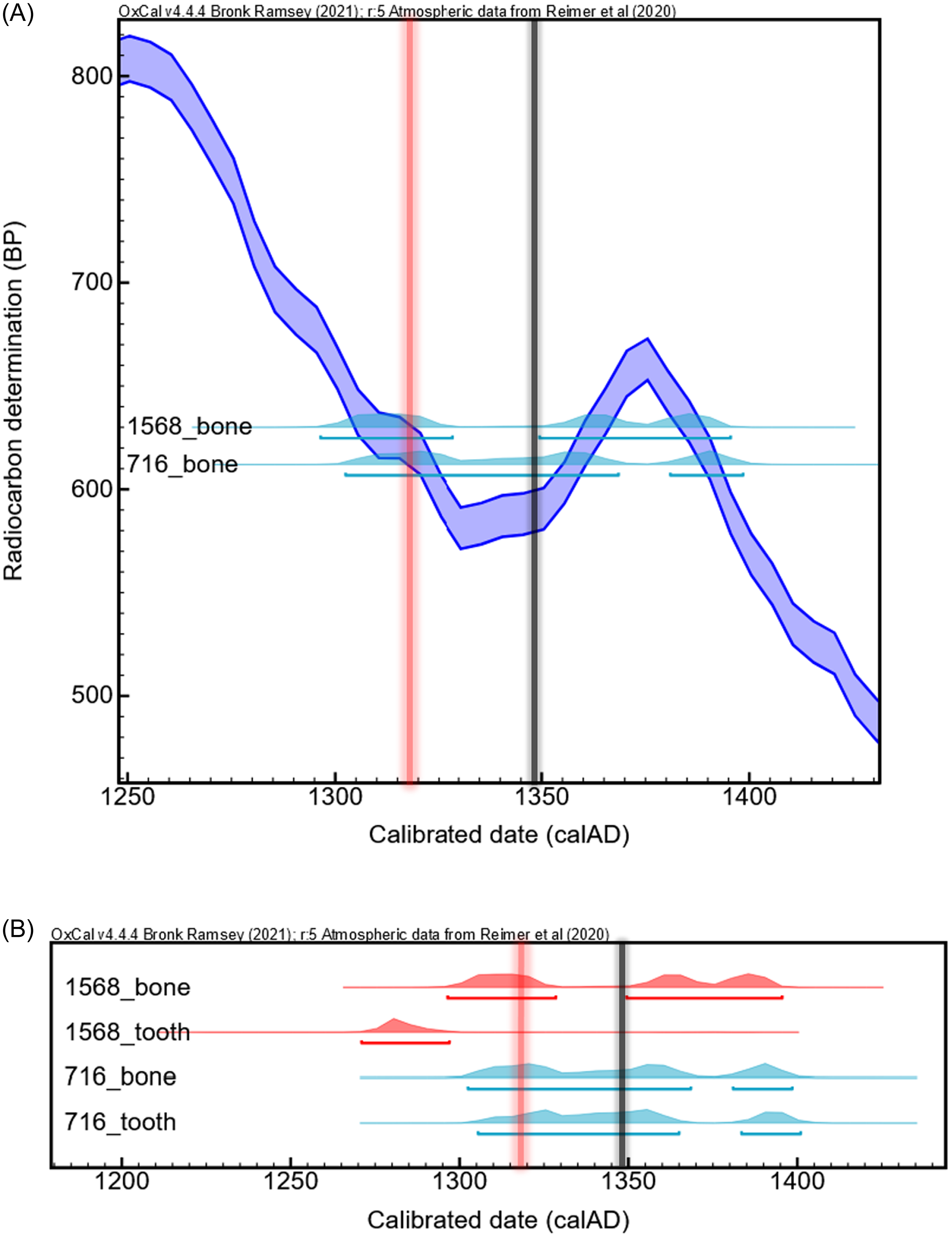
Figure 3. Examples of radiocarbon dating results. (A) Multiple resulting intervals for bones of two individuals (1568 and 716) with resolution too low to distinguish famine from plague event. (B) The results of tooth of the individual No. 1568 (juvenis) has anchored the individual to the famine event. For the individual No. 716 (maturus) the assessing of bone-tooth pair results has no helpful effect. Vertical lines mark event of famine (red, 1318 CE) and plague (black, 1348 CE).

Figure 4. Seven pairs where the radiocarbon dating results are anchored to famine (red) or plague (back) event. Vertical lines mark event of famine (red, 1318 CE) and plague (black, 1348 CE).
For the modeling, the single-sampled individuals were excluded. 2 of 11 these solitary samples from individuals 114 and 1835 (found outside the mass graves) were dated to a significantly younger period than the first half of the 14th century (Figure 5). The remaining nine single-sampled individuals cannot be conclusively linked to either famine or plague.
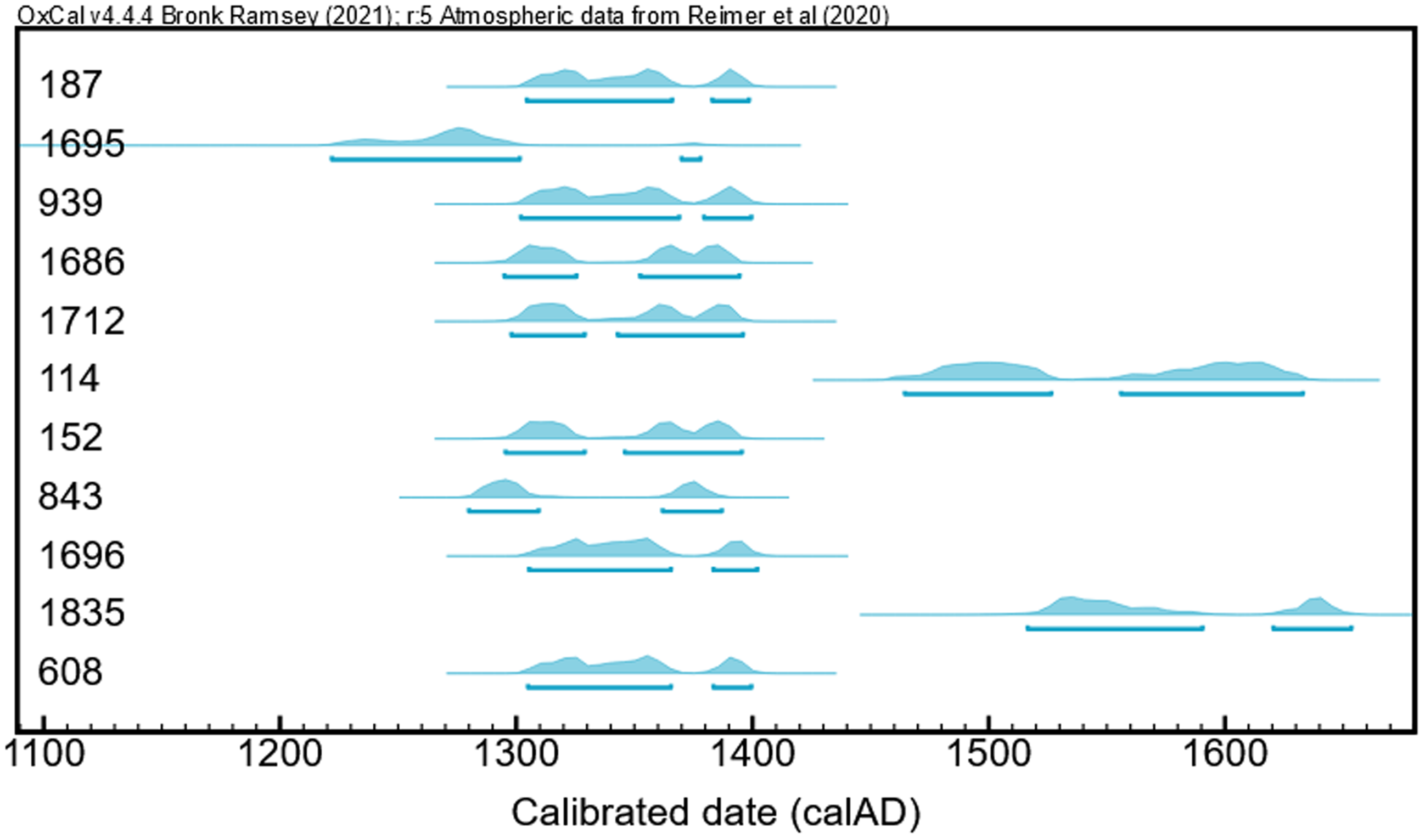
Figure 5. Radiocarbon dating of bones from single-sampled single-buried individuals.
The results of the Bayes model are summarized on Figure 6. Twenty individuals are found to be victims of famine, 66 of plague. The average age of the deceased is 35.6 ± 17.4 years (famine) and 38.0 ± 18.8 (plague).
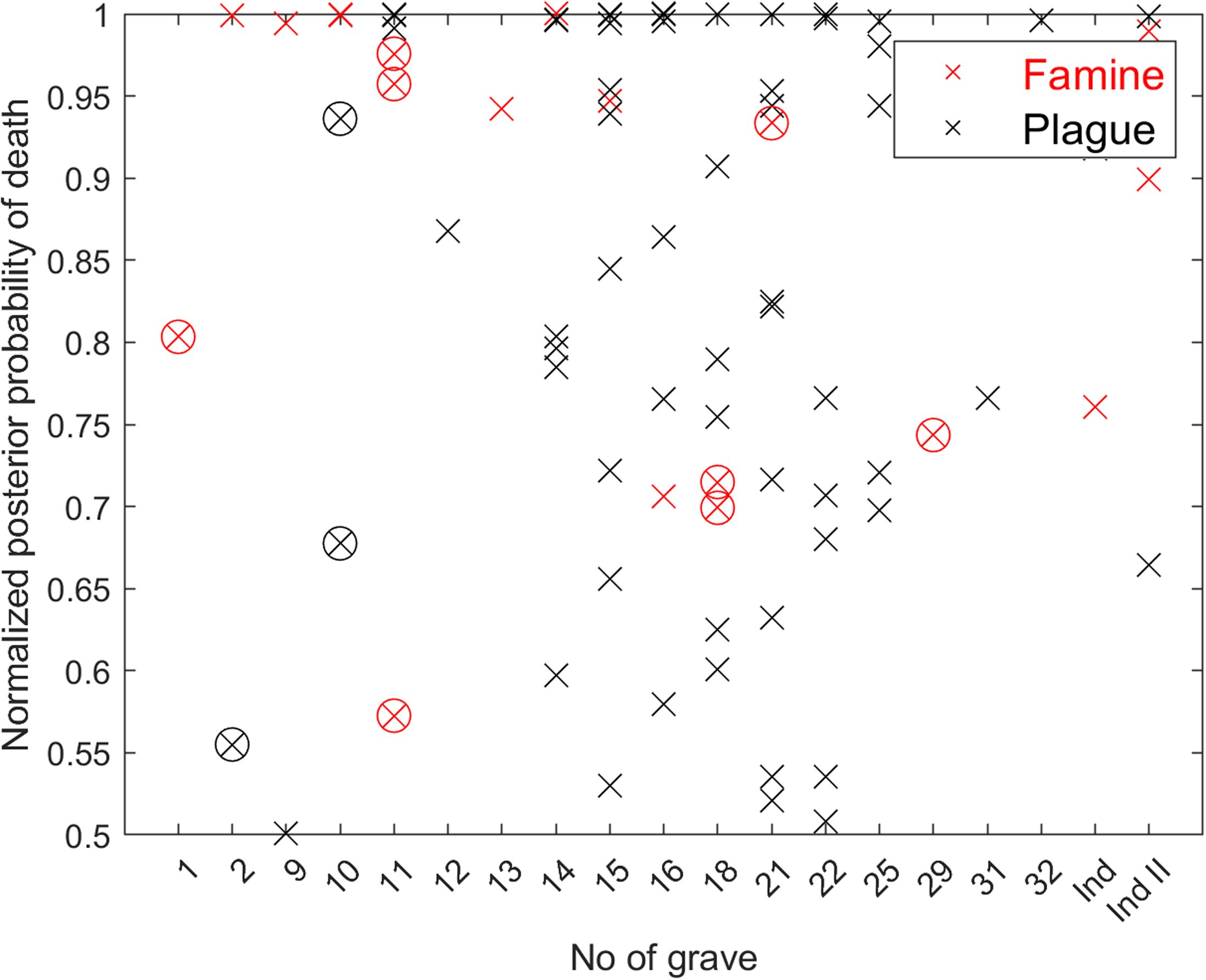
Figure 6. Normalized posterior probability of death due to famine (red cross markers) or plague (black cross markers) for the individuals across different graves. Discrepancies between the model and stratigraphy estimates are highlighted with colored circle symbols.
The model agrees with the radiocarbon dating of all seven pairs anchored by bone-tooth combination.
Compared to the stratigraphic estimates (Supplementary Table 1), the model aligns with 23 out of 34 individuals (68%). In eight cases, the model predicts famine as the more likely cause of death, whereas stratigraphy attributes it to plague. For the remaining three individuals, the opposite is observed. In graves No. 1, 2, 10 and 29, which contain only one or a few individuals, this discrepancy cannot be resolved due to lack of additional information, making both interpretations potentially valid.
In grave No. 18, the model associates’ individuals 469 and 505 with the famine event, while the remaining six buried individuals are linked to the plague event, contrary to the stratigraphic estimate that suggest all died of plague. Similarly, in grave No. 21, which is also stratigraphically identified as plague grave, the model predicts that individual 253 died of famine, while all nine other individuals are attributed to the plague. Given this context, it is likely that the stratigraphic interpretation is more reliable for graves No. 18 and 21.
Grave No. 11 presents a more complex situation. It contains four young individuals and one senior individual, all stratigraphically placed in the plague event. However, the model identifies three of them as famine victims, two with high probability, including the senior individual 738, and three as plague victims with similarly high probability. This raise concerns whether grave No. 11 represents a single mass burial or if its history is more complex, potentially involving a secondary burial.
If all individuals from graves No. 18 and 29 are assigned to the plague event, the number of individuals attributed to famine decreases to 17, while the number of plague victims rises to 69. With this adjustment, the corrected average age of death is 37.3 ± 18.9 years (famine) and 37.5 ± 18.9 (plague).
Supplementary Table 1 also summarizes the results of CN stable isotope analysis for a subset of the collagen-bone samples, where enough material was isolated for triplicate analysis. The δ 15N ratios ranged from 9.5 to 14.3‰, with the highest value observed in the remains of a child who died between the ages of 7 and 13. The δ 13C values varied between –23.7‰ and –17.8‰. There is no statistically significant difference between the average δ15N and δ13C values from the remains of individuals who, according to the model, died of plague or famine.
Conclusion
The excavation near the Chapel of All Saints with the ossuary in Kutná Hora–Sedlec provided unique evidence of medieval plague and famine epidemics in the Czech Republic. Unfortunately, stratigraphic and archaeological data allowed for the interpretation of only six plague mass graves and three famine mass graves. Radiocarbon dating was also challenging due to the short time gap between the two events and the problematic shape of the calibration curve for the period in question. However, Bayesian modeling of 172 calibrated AMS ages from teeth and bones of 86 individuals provided substantial assistance in the interpretation of a number of individuals and also several mass graves. The Bayesian model significantly contributed to uncovering the extent of the plague, which was previously believed to have had only a minor impact on the Czech landscape, and to confirming the famine event. The model aligns with stratigraphic and archaeological interpretation in 23 out of 34 cases, and in all seven cases based on calibration data. To further validate our model, DNA analysis of the studied individuals is essential to confirm the presence of Yersisnia pestis.
Supplementary material
To view supplementary material for this article, please visit https://doi.org/10.1017/RDC.2025.18
Acknowledgments
This study was supported by the Czech Science Foundation (project no. GA21-09637S) and also by the MYES project “Ready for the future: understanding the long-term resilience of the human culture (RES-HUM)”, project reg. number: CZ.02.01.01/00/22_008/0004593.

